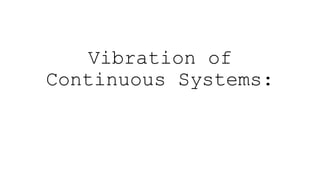Vibration of Continuous Systems.pjjjjjjjjptx
•Download as PPTX, PDF•
0 likes•32 views
kkkkkkkk
Report
Share
Report
Share

Recommended
2_Introduction Classification of Structure.pptx

It is about the fundamentals of Analysis of Determinate Structures
THEORY OF VIBRATION.pptx

yesssssssssssssssssssssssssssssssssssssssssssssssssssssssssssssssssssssssssssssssssssssssssssssssssssssssssssssssssssssssssssssssssssssssssssssssssssssssssssssssssss
Glossary of spinal deformity biomechanical terms

I am a passionate and driven academic who is committed to multidisciplinary working (health/clinical). I strive to ensure that the interrelationship between research informed teaching and enterprise informed teaching is maintained to enhance the delivery of undergraduate and postgraduate curriculums. I have a particular interest in the role of spinal biomechanics & spinal orthotics.
Recommended
2_Introduction Classification of Structure.pptx

It is about the fundamentals of Analysis of Determinate Structures
THEORY OF VIBRATION.pptx

yesssssssssssssssssssssssssssssssssssssssssssssssssssssssssssssssssssssssssssssssssssssssssssssssssssssssssssssssssssssssssssssssssssssssssssssssssssssssssssssssssss
Glossary of spinal deformity biomechanical terms

I am a passionate and driven academic who is committed to multidisciplinary working (health/clinical). I strive to ensure that the interrelationship between research informed teaching and enterprise informed teaching is maintained to enhance the delivery of undergraduate and postgraduate curriculums. I have a particular interest in the role of spinal biomechanics & spinal orthotics.
More Related Content
More from joshuaclack73
More from joshuaclack73 (20)
Multi Degrees of Freedom.pptxjjjjjjjjjjjjjjjjjjjjjj

Multi Degrees of Freedom.pptxjjjjjjjjjjjjjjjjjjjjjj
Matlab Tasks – Modelling an electronic circuit filter.pptx

Matlab Tasks – Modelling an electronic circuit filter.pptx
Matlab Tasks – Modelling an electronic circuit filter.pptx

Matlab Tasks – Modelling an electronic circuit filter.pptx
Vibration of Continuous Systems.pjjjjjjjjptx
- 2. Discrete lumped mass: • §Discrete model • the governing equations are ordinary differential equations, • relatively easy to solve. • §In many cases, known as distributed or continuous systems, it is not possible to identify discrete masses, dampers. • §A continuous distribution of the mass, damping, and elasticity • each of the infinite number of points of the system can vibrate. • ♾ degrees of freedom. • §Continuous model, the governing equations are
- 3. Continuous Systems: §Examples are: • A string • A shaft (torsional) • A beam (longitudinal and transverse) • A membrane (plate-transverse) § infinite degrees of freedom = infinite modes of vibration!!! §1-n 1st, 2nd, 3rd,……..nth § Each with a characteristic frequency and mode shape. §Can ‘all’ be occurring simultaneously- lower order ones tend to dominate
- 4. Continuous Systems: An added (essential!!!) factor is that the modes of vibration also depend on how the system is fixed in space- • Simply supported • Clamped • Free • Any external forces or moments
- 6. Solutions:
- 7. Transverse (Lateral) vibration of simple beams: